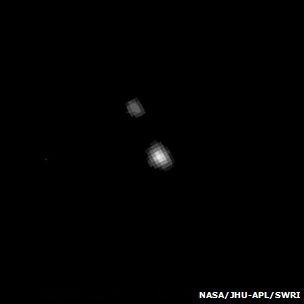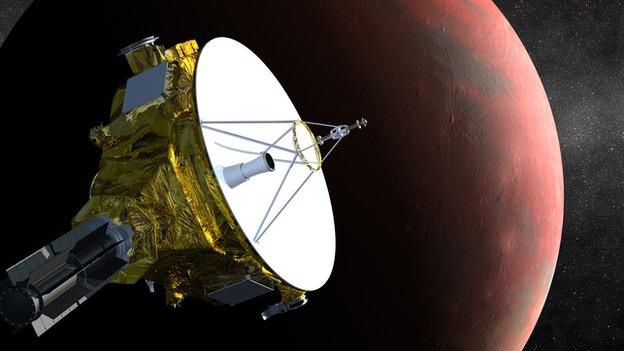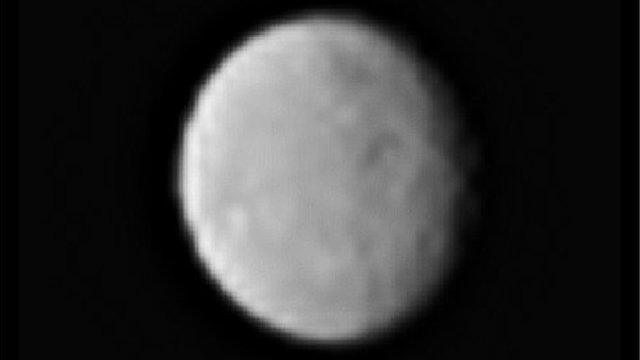New Horizons mission eyes Pluto
- Published

Pluto (centre) pictured with Charon, taken from a distance of just over 200 million km
The New Horizons probe has returned new pictures of the dwarf planet Pluto and its largest moon, Charon.
They are the first images since the Nasa mission formally began its countdown to a flyby of the distant world in July.
Pluto and its satellite appear as white blobs in the photos, which were taken from a separation of 200 million km.
But come May, New Horizons will return views of the dwarf – 5bn km from Earth - that better anything from the Hubble.
There is not much science that can be done with these early pictures.
Their primary use is to make sure the probe is lined up properly for its historic rendezvous in just over five months.
Controllers will be conducting a number of these optical navigation surveys.
They need to be sure as well that New Horizons is not heading for any debris that may be moving around the Pluto system when it barrels through at 13km/s.
The first of any adjustments in the spacecraft’s trajectory will begin in March.
Birthday shot
Nasa released the new image set on the 109th birthday of Clyde Tombaugh, who discovered the distant icy world in 1930.
The American astronomer died in 1997, but his daughter, Annette Tombaugh, commented: “My dad would be thrilled with New Horizons.
"To actually see the planet that he had discovered, and find out more about it - to get to see the moons of Pluto - he would have been astounded.
“I'm sure it would have meant so much to him if he were still alive today.”
Pluto has five known moons. In the new images only Charon shows up in the tenth of a second exposure.
Longer exposures acquired in due course will reveal the other satellites, and perhaps additional objects that are bound gravitationally to Pluto.
The picture shown on this page was taken by New Horizons' Long-Range Reconnaissance Imager (LORRI).
This is the main telescope and camera system onboard. At closest approach to Pluto on 14 July, it will capture details of the surface at under 100m per pixel.
Pluto is the last of the "classical nine" planets to be visited by a spacecraft.
In 2006, it was redesignated as a "dwarf planet" by the International Astronomical Union. These small worlds are the most numerous planet class in the Solar System.

When it gets to Pluto, the New Horizons probe will have a packed schedule of observations
Jonathan.Amos-INTERNET@bbc.co.uk and follow me on Twitter: @BBCAmos, external
- Published25 January 2015

- Published19 January 2015

- Published9 January 2015